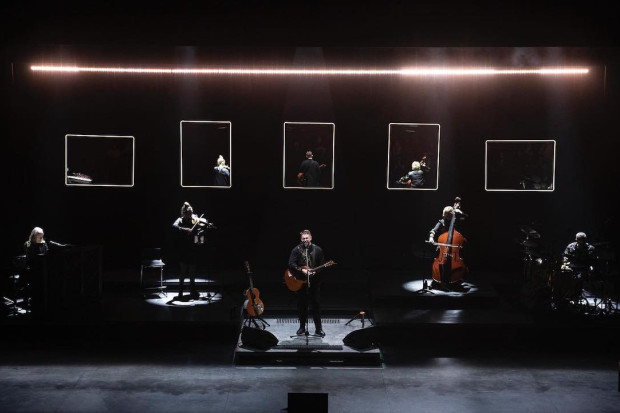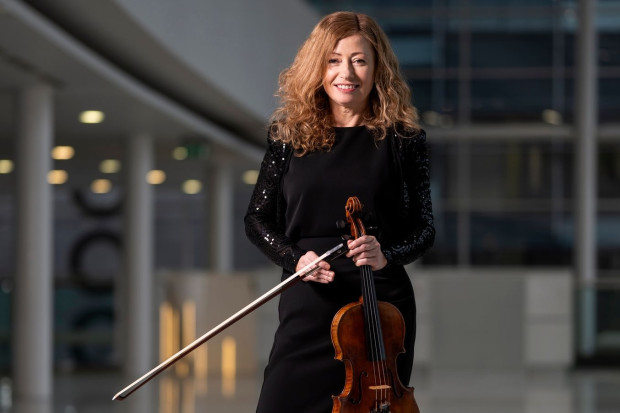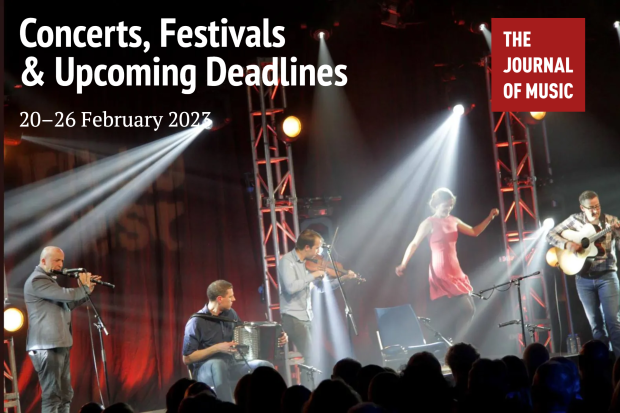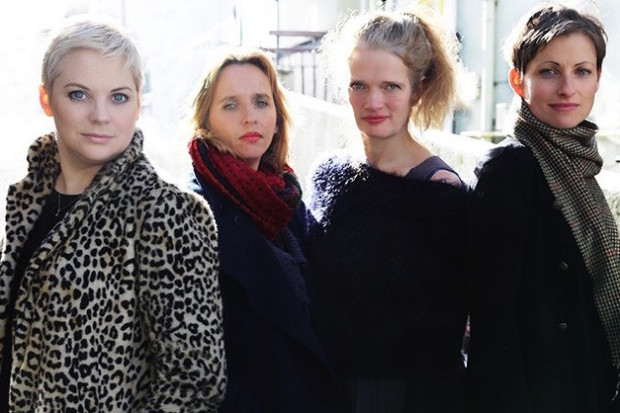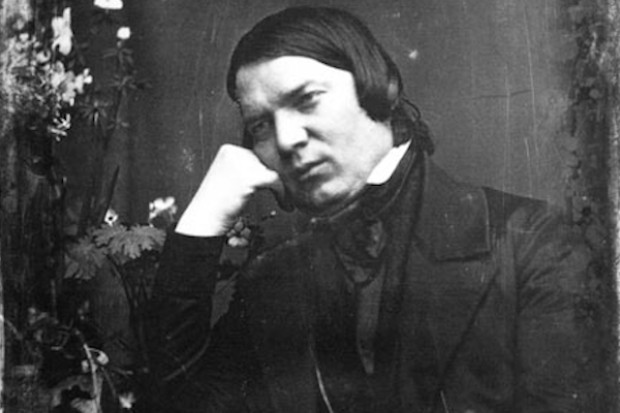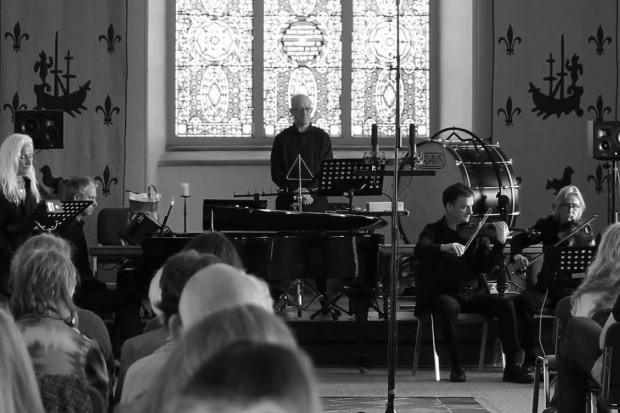
Camille Thomas and the Irish Chamber Orchestra at Cellissimo (Photo: Mike Shaugnessy)
An Ambitious Musical Exploration of Migration and the Climate Crisis
The lockdowns of 2020 and 2021 necessitated the inaugural Cellissimo, a festival founded by Music for Galway and led by CEO Anna Lardi and Artistic Director Finghin Collins, to be held online. Though it was one of the better online festivals I watched – I suppose that’s the right verb – it is of course a very different experience to be in the room with the music as it’s made. And so last weekend I made the journey to Galway for the opening days of what you could call the second inaugural Cellissimo.
The festival, ongoing as I write this, has a theme. It’s part of a partnership with three other European festivals (and one gaming company) linked under the Songs of Travel umbrella, conceived by Lardi and aiming to increase empathy around the climate crisis and migration, as well as to demonstrate a more sustainable approach to music festivals.
The opening concert featured two concerti alongside Mendelssohn’s Calm Sea and Prosperous Voyage, performed by the National Symphony Orchestra and a number of soloists with conductor Gavin Maloney, and also a keynote address by former president Mary Robinson.
Djuro Zivkovic’s The Earth’s Concerto for cello, piano and orchestra, which received its world premiere by Jakob Koranyi and Finghin Collins, was a powerful and convincing work. The soloists featured individually first, with the piano and orchestra trading spiky clusters, followed by an equally punchy passage for cello and bells, before giving way to a lyrical duo for the leading instruments. Lyricism was at the heart of the second movement as well, Koranyi and Collins in concord over an increasingly unsettled percussion-led texture, with the whole movement bookended by a pair of dark fanfares. The third movement was more energetic (though unfortunately Koranyi’s cello was sometimes lost in the weight of sound), ending with a major chord blasted by the brass – not with the sense of peace or relief sometimes found from an atonal work ending with a clear consonance, but instead revealed from the dense texture like the flare of light at the end of an eclipse.
At the commencement of a festival about travel, this concert was a journey backwards through time; after the Zivkovic was an older cello concerto, with a different soloist, as Alban Gerhardt performed Shostakovich’s second, before the orchestra finished with the Mendelssohn. Gerhardt’s opening statement in the Shostakovich was commanding, a powerful force for the orchestra to match. During the second movement there was a period when the orchestra seemed to lose focus (it was otherwise indomitable); soloist and conductor seemed to work together to get things back on track. Gerhardt’s vast sound and charismatic persona make him a natural partner for a large orchestra, and brought an assured finale.
On Monday morning, Gerhardt gave a masterclass taking members of the International Student Programme through one of their repertoire pieces each and refining it. The details of cello technique are about as familiar to me as those of biochemistry, but seeing a musical process brought into focus like this is always rewarding.

Jakob Koranyi in Djuro Zivkovic’s The Earth’s Concerto (Photo: Mike Shaugnessy)
Game for music
Songs of Travel is a collaborative project with three festivals from Sweden, Norway and the Netherlands – Fairplay Chamber Music, Valdres Sommersymfoni, and Piano Biënnale – and the game developer Causa Creations in Austria. Its output includes new works, an education resource, and a motion comic game with a score by Elaine Agnew. Anna Lardi played the game on stage at the Black Box theatre on Sunday afternoon, with live music on piano, violin, cello, clarinet and percussion performed by Daria van den Bercken, Bogdan Sofei, Jakob Koranyi, Macdara Ó Seireadáin and Alex Petcu. The second half of the concert featured a panel discussion led by Esther Osayimwen from Galway City Partnership, followed by a suite arrangement of the music.
As a performance, the game, which features the stories of five migrants to or across Europe, didn’t work perfectly. Motion comics are among the least interactive sorts of videogame, with the only real decision being how fast to move through it, so in this case it was a little incongruous. Glance away from the screen to watch the musicians and you may miss a story detail; at other times you might lose patience. It was a little like reading a comic over someone’s shoulder.
But there are aspects fitted to the medium, or breathtakingly human. The Vietnamese-German Vân relates her typical day and the comic moves not horizontally but rotationally, images placed around the face of a clock. Later, the Ukrainian Olga’s fitness tracker repeatedly tells her her heart rate is dangerously high as she walks along a highway bridge that divides her country’s army from Russia’s.
Agnew’s music was integrated in the moments of the story, with some use of leitmotifs – a tune for the story’s overall narrator Jack (from a real tune that his brother gave him as a parting gift), or a woodblock motif representing and mimicking an email notification tone. The sections themselves weren’t always distinct from one another, though, so the resulting suite, Waiting, had captivating moments but was not always convincing.
The game is a locus for the festival’s themes, and while the execution wasn’t as ambitious as the concept, it had its charm, and never lost sight of its goals.

Daria van den Bercken, Bogdan Sofei, Macdara Ó Seireadáin, Alex Petcu and Jakob Koranyi performing with the Songs of Travel interactive comic (Photo: Avi Ratnayake)
Stradivari history
Sunday evening brought another orchestral concert, this time the Irish Chamber Orchestra directed by Katherine Hunka with featured cellist Camille Thomas. Bookending the cello works were pieces for the orchestra alone: Sibelius’ Andante Festivo and Grieg’s Holberg Suite. The former in particular is well-known, but the orchestra took it at a fairly quick andante, and it was all the better for it, spending less time luxuriating in the individual chords and allowing structure and phrase shape to be the main concerns.
Thomas plays on a slim cello made by Stradivarius in the last years of his life. An investment in an instrument like that requires an investment in its history, and this one has passed through the hands of Ernest De Munck and Emanuel Feuermann (for both of whom it’s named) as well as the French Romantic cellist-composer Auguste Franchomme, in whom Thomas has developed a keen interest. A friend of Chopin, Franchomme’s arrangements for four cellos of the ‘Raindrop’ prelude and the funeral march from the second piano sonata were something of a revelation to me: Chopin’s music is so pianistic that I considered it all but impossible to arrange for other instruments. These versions felt native to the cello.
Franchomme’s Air Russe Varié (variations, in fact, on a Ukrainian theme) for cello and orchestra was less interesting compositionally, but served as a showcase for the cello and for Thomas’ mastery of it. This is a work that plays very much to Thomas’ rich sound and immaculate cantabile, but she showed her dexterity with C.P.E. Bach’s more nimble A minor cello concerto. She is a natural soloist and an excellent partner to the orchestra, with a palpable sense of communication and camaraderie.
Attendees of the Sunday night concert got a taste of the next day as Thomas concluded with an encore of the Prelude from Bach’s first cello suite, which she performed in full at St Nicholas’ Collegiate Church on Monday. I wondered how well her sound would sit in the already resonant acoustic of the church. But Thomas is sensitive, and despite the intimidating combination of a full-bodied cello, a very rich acoustic, and a naturally warm playing style, the clarity of articulation and shape of phrase in the Bach were never lost, even when notes echoed for seconds throughout the nave.
Thomas opened the performance with Pablo Casals’ Song of the Birds, which she connected to the Bach suite without a break. There followed a pair of virtuosic Romantic works: more Franchomme – the beautiful Adagio from his 12 études – and Alfredo Piatti’s seventh caprice. Unfortunately I had to miss the new Donnacha Dennehy work, Unfurling, which was scheduled for this concert but premiered at a later one by Jakob Koranyi.
 Camille Thomas and the Irish Chamber Orchestra (Photo: Mike Shaugnessy)
Camille Thomas and the Irish Chamber Orchestra (Photo: Mike Shaugnessy)
Hope in the climate crisis
Mary Robinson’s keynote speech during the first concert was a festival highlight for me. Robinson is an extraordinary orator and her speech explored the climate crisis, its impact on the developing world and consequently on human rights and migration, the danger of ecosystem collapse, the support given by governments to the industry causing these threats, and the role of art in the face of them. It was a speech that made no secret of the urgency we face, but one with a hopeful tone.
The message is being delivered at least. Every event I attended bar the masterclass was at or near capacity, and events ended with a survey about travel methods and sustainability. Music descriptions were given verbally (to save paper), and the event programme featured information about sustainability and green initiatives. Not every aspect of the festival I saw worked for me, but it’s built with a clear theme, and never short of ideas or ambition. Cellissimo 2024 is a music festival where the music-making is excellent, but that’s only part of what makes it special.
Cellissimo continues until Sunday 26 May with Natalie Clein, Nicolas Altstaedt, world premieres by Karmit Fadael, Jennifer Walshe and Anne-Marie O’Farrell, a Cellissimo Spectacular with Claudia Boyle, an Inishbofin Cello Trail, and more. For full details, visit https://musicforgalway.ie/cellissimo-2024/.
Subscribe to our newsletter.

Finghin Collins, Artistic Director of Music for Galway and Cellissimo, and Mary Robinson at the opening concert (Photo: Mike Shaugnessy)
 Finghin Collins, Mayor of Galway Eddie Hoare, Anna Lardi (CEO of Music for Galway), Mary Robinson, and Dan Shields of the Board of Music for Galway (Photo: Mike Shaugnessy)
Finghin Collins, Mayor of Galway Eddie Hoare, Anna Lardi (CEO of Music for Galway), Mary Robinson, and Dan Shields of the Board of Music for Galway (Photo: Mike Shaugnessy)
Published on 22 May 2024
Brendan Finan is a teacher and writer. Visit www.brendanfinan.net.












